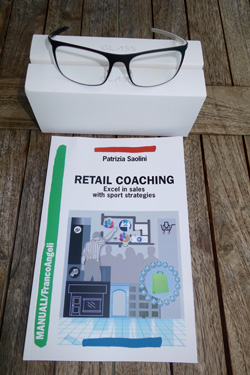 Here it is my book Retail Coaching: Excel in Sales with sport strategies next to Google Glass just landed both on my desk and ready to try!
Here it is my book Retail Coaching: Excel in Sales with sport strategies next to Google Glass just landed both on my desk and ready to try!
If you would like to read my book, which I think is easier (maybe less cool than Google Glass but easier to get) I suggest start reading the following considerations about one of the contents: what do we measure in the ROI of Coaching?
The first consideration in measuring the ROI of Coaching is based upon the work of Kirkpatrick (1975) and later enhanced by Phillips (1995). This approach includes evaluating programs at five levels represented below. These levels represent tangible measures of the coaching program which I’m glad to introduce to you with Lisa Ann Edwards, M.S. ACC and partner at Bloom Coaching Institute.
Level 1: Reaction and satisfaction. In this level, we measure participants’ reaction to the program and stakeholder satisfaction with the program and the planned implementation. Examples include: Client’s satisfaction with the coach, relevance of the coaching to the client’s job, client’s planned actions and willingness of the client to recommend coaching to others.
Level 2: Learning. In this level we measure skills, knowledge, or attitude changes related to the program and implementation. Examples include: Client’s learning about their own strength and weaknesses, client’s learning of specific skills which the coach may be coaching them on such as selling skills, customer service skills, communication skills and business operations or management skills.
Level 3: Application and implementation. In this level, we measure changes in behavior on the job and specific application and implementation of the program. Examples include: Client’s changes in behavior as captured in a 360, or from their manager or direct reports. In a retail sales organization with frontline sales people receiving coaching, we might also capture changes behavior through customer service or secret shopper surveys.
Level 4: Business impact. In this level, we measure business impact changes related to the program. In a sales organization, we are typically looking at increased revenue, however what is important is to align the coaching with specific revenue goals. Many times, clients identify more than one measure of business impact and it is not uncommon for the client to be required to choose from five or six measures as defined by the organization.
What is important in this measure is to isolate for the effects of a coaching program. For example, if we are implementing a coaching program in tandem with a retail selling training program or in tandem with pricing or marketing changes, we know that there are other factors aside from the coaching that may be impacting the business. There are multiple ways to isolate for the effects f the coaching program including: control vs. experimental groups, participant estimate and trend analysis.
Level 5: Return on investment (ROI). And finally, in this level, we compare the monetary value of the business impact with the costs of the program. What is important in this level is to capture fully loaded costs. In other words, we must capture the cost of the client’s time, administrative time, overhead costs for use of facilities and so on. ROI is then calculated by taking the net benefits (total monetary improvement isolated to the program, less the fully loaded cost of the program), divided by the fully loaded cost of the program then multiplied by 100 to arrive at the percent ROI.
These five levels of evaluation are the tangible measures of the program and can be reported to the client.
Additionally, we know that coaching allows for intangible benefits. These include:
- Improved customer satisfaction ratings
- Improved employee engagement ratings
- Improved job satisfaction ratings
Are you ready to start the ROI of Coaching? Seems like I’m ready to try that Glass either!
Related links:

